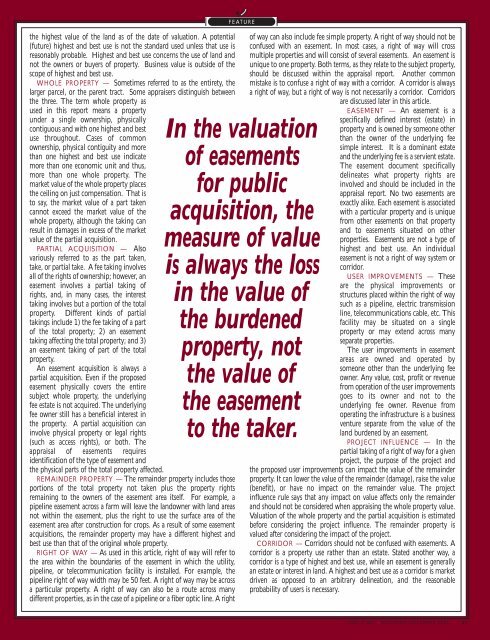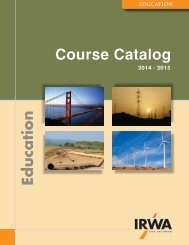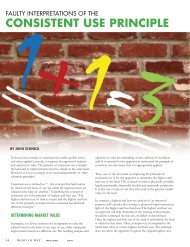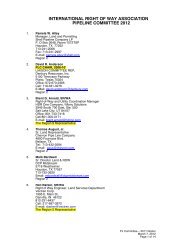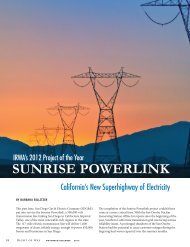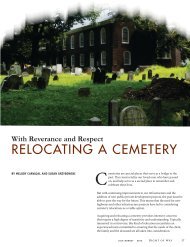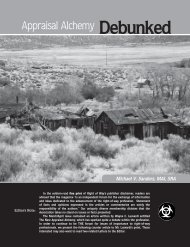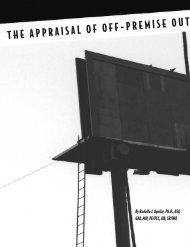The Appraisal of Easements - International Right of Way Association
The Appraisal of Easements - International Right of Way Association
The Appraisal of Easements - International Right of Way Association
- No tags were found...
Create successful ePaper yourself
Turn your PDF publications into a flip-book with our unique Google optimized e-Paper software.
the highest value <strong>of</strong> the land as <strong>of</strong> the date <strong>of</strong> valuation. A potential(future) highest and best use is not the standard used unless that use isreasonably probable. Highest and best use concerns the use <strong>of</strong> land andnot the owners or buyers <strong>of</strong> property. Business value is outside <strong>of</strong> thescope <strong>of</strong> highest and best use.WHOLE PROPERTY — Sometimes referred to as the entirety, thelarger parcel, or the parent tract. Some appraisers distinguish betweenthe three. <strong>The</strong> term whole property asused in this report means a propertyunder a single ownership, physicallycontiguous and with one highest and bestuse throughout. Cases <strong>of</strong> commonownership, physical contiguity and morethan one highest and best use indicatemore than one economic unit and thus,more than one whole property. <strong>The</strong>market value <strong>of</strong> the whole property placesthe ceiling on just compensation. That isto say, the market value <strong>of</strong> a part takencannot exceed the market value <strong>of</strong> thewhole property, although the taking canresult in damages in excess <strong>of</strong> the marketvalue <strong>of</strong> the partial acquisition.PARTIAL ACQUISITION — Alsovariously referred to as the part taken,take, or partial take. A fee taking involvesall <strong>of</strong> the rights <strong>of</strong> ownership; however, aneasement involves a partial taking <strong>of</strong>rights, and, in many cases, the interesttaking involves but a portion <strong>of</strong> the totalproperty. Different kinds <strong>of</strong> partialtakings include 1) the fee taking <strong>of</strong> a part<strong>of</strong> the total property; 2) an easementtaking affecting the total property; and 3)an easement taking <strong>of</strong> part <strong>of</strong> the totalproperty.An easement acquisition is always apartial acquisition. Even if the proposedeasement physically covers the entiresubject whole property, the underlyingfee estate is not acquired. <strong>The</strong> underlyingfee owner still has a beneficial interest inthe property. A partial acquisition caninvolve physical property or legal rights(such as access rights), or both. <strong>The</strong>appraisal <strong>of</strong> easements requiresidentification <strong>of</strong> the type <strong>of</strong> easement andthe physical parts <strong>of</strong> the total property affected.REMAINDER PROPERTY — <strong>The</strong> remainder property includes thoseportions <strong>of</strong> the total property not taken plus the property rightsremaining to the owners <strong>of</strong> the easement area itself. For example, apipeline easement across a farm will leave the landowner with land areasnot within the easement, plus the right to use the surface area <strong>of</strong> theeasement area after construction for crops. As a result <strong>of</strong> some easementacquisitions, the remainder property may have a different highest andbest use than that <strong>of</strong> the original whole property.RIGHT OF WAY — As used in this article, right <strong>of</strong> way will refer tothe area within the boundaries <strong>of</strong> the easement in which the utility,pipeline, or telecommunication facility is installed. For example, thepipeline right <strong>of</strong> way width may be 50 feet. A right <strong>of</strong> way may be acrossa particular property. A right <strong>of</strong> way can also be a route across manydifferent properties, as in the case <strong>of</strong> a pipeline or a fiber optic line. A rightFEATUREIn the valuation<strong>of</strong> easementsfor publicacquisition, themeasure <strong>of</strong> valueis always the lossin the value <strong>of</strong>the burdenedproperty, notthe value <strong>of</strong>the easementto the taker.<strong>of</strong> way can also include fee simple property. A right <strong>of</strong> way should not beconfused with an easement. In most cases, a right <strong>of</strong> way will crossmultiple properties and will consist <strong>of</strong> several easements. An easement isunique to one property. Both terms, as they relate to the subject property,should be discussed within the appraisal report. Another commonmistake is to confuse a right <strong>of</strong> way with a corridor. A corridor is alwaysa right <strong>of</strong> way, but a right <strong>of</strong> way is not necessarily a corridor. Corridorsare discussed later in this article.EASEMENT — An easement is aspecifically defined interest (estate) inproperty and is owned by someone otherthan the owner <strong>of</strong> the underlying feesimple interest. It is a dominant estateand the underlying fee is a servient estate.<strong>The</strong> easement document specificallydelineates what property rights areinvolved and should be included in theappraisal report. No two easements areexactly alike. Each easement is associatedwith a particular property and is uniquefrom other easements on that propertyand to easements situated on otherproperties. <strong>Easements</strong> are not a type <strong>of</strong>highest and best use. An individualeasement is not a right <strong>of</strong> way system orcorridor.USER IMPROVEMENTS — <strong>The</strong>seare the physical improvements orstructures placed within the right <strong>of</strong> waysuch as a pipeline, electric transmissionline, telecommunications cable, etc. Thisfacility may be situated on a singleproperty or may extend across manyseparate properties.<strong>The</strong> user improvements in easementareas are owned and operated bysomeone other than the underlying feeowner. Any value, cost, pr<strong>of</strong>it or revenuefrom operation <strong>of</strong> the user improvementsgoes to its owner and not to theunderlying fee owner. Revenue fromoperating the infrastructure is a businessventure separate from the value <strong>of</strong> theland burdened by an easement.PROJECT INFLUENCE — In thepartial taking <strong>of</strong> a right <strong>of</strong> way for a givenproject, the purpose <strong>of</strong> the project andthe proposed user improvements can impact the value <strong>of</strong> the remainderproperty. It can lower the value <strong>of</strong> the remainder (damage), raise the value(benefit), or have no impact on the remainder value. <strong>The</strong> projectinfluence rule says that any impact on value affects only the remainderand should not be considered when appraising the whole property value.Valuation <strong>of</strong> the whole property and the partial acquisition is estimatedbefore considering the project influence. <strong>The</strong> remainder property isvalued after considering the impact <strong>of</strong> the project.CORRIDOR — Corridors should not be confused with easements. Acorridor is a property use rather than an estate. Stated another way, acorridor is a type <strong>of</strong> highest and best use, while an easement is generallyan estate or interest in land. A highest and best use as a corridor is marketdriven as opposed to an arbitrary delineation, and the reasonableprobability <strong>of</strong> users is necessary.right <strong>of</strong> way ✦ NOVEMBER/DECEMBER 2001 41


